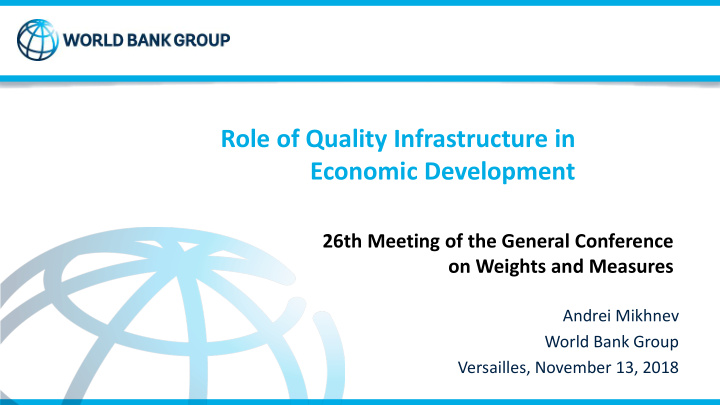



Role of Quality Infrastructure in Economic Development 26th Meeting of the General Conference on Weights and Measures Andrei Mikhnev World Bank Group Versailles, November 13, 2018
Linking Quality Infrastructure to the Economic Development Agenda A conducive infrastructure that assures the quality of products and services is a critical enabler for firms to access and compete in domestic and foreign markets, therefore broadening their trade and investment opportunities and boosting their productivity and innovation. A modern quality infrastructure serves the needs of governments, businesses, and consumers. 2
Understanding Quality Infrastructure The Quality Infrastructure (QI) denotes the ecosystem of public and private institutions together with the policies, relevant legal and regulatory framework, and practices needed to support and enhance the quality, safety and environmental soundness of goods, services, and processes. QI relies on metrology, standardization, accreditation, conformity assessment, and market surveillance.
Quality Infrastructure: Productivity Policies to improve firm performance shall focus on the firms capabilities for upgrading the quality of their outputs and the cultivation of demand for higher quality. Over the long run, raising product quality and an affordable access to quality assurance services may increase a firm’s productivity. A firm’s ability to demonstrate quality and safety of goods and services, and to comply with international standards, is often necessary to enter desirable export markets. Demonstrating such compliance requires a sound quality infrastructure (QI) ecosystem. Standards lead to economies of scale, allowing suppliers to achieve Lower costs per unit by producing large, homogeneous batches of products. https://openknowledge.worldbank.org/handle/10986/30588 4
Quality Infrastructure: Industrial Development “…rather than aiming to produce a product per se, the attention should be on expanding the activities that deliver the desirable characteristics…” For the manufacturing industry, it is more urgent than ever to meet this standardization challenge. The ability to meet international standards has affected developing countries’ opportunities to access export markets. With more complex products and processes, improving quality infrastructure (QI) systems to certify quality standards will become arguably more important than before to facilitate export opportunities. If QI requirements are set too high, they function as nontariff barriers to trade and development. https://openknowledge.worldbank.org/handle/10986/27946 5
Quality Infrastructure: Innovation “…countries unable to innovate in their present industries are unlikely to do so in new industries”. Investments in innovation per se does not help innovative products succeed without the existence of underlining conditions for innovation, including the quality infrastructure. The use of standards for innovation is a central element of the QI system. Better-quality firms tend to have greater success in meeting the more stringent international standards. Having these capabilities is key for competing in quality in world markets. Standards spur and disseminate innovation, solve coordination failures, and facilitate the development of profitable networks. Conformity assessments also facilitate innovation, enabling firms to test new products before launching them. https://openknowledge.worldbank.org/handle/10986/28341 6
Quality Infrastructure: Trade and Competitiveness Effective national quality infrastructure (NQI) consistent with internationally accepted and required practices, can improve trade and access to markets and promote competitiveness by helping firms produce goods and services that meet the quality specifications of global markets. Countries can support business competitiveness by diffusing standards, streamlining technical regulations, and harmonizing them with regional and international trade partners. Developing a NQI involves not only helping firms improving their quality, but also signaling this quality with standards compliance. This requires domestic infrastructure for conformity assessment; otherwise, firms are forced to be certified in third countries, increasing significantly the sunk costs of exporting. https://openknowledge.worldbank.org/handle/10986/6768 https://openknowledge.worldbank.org/handle/10986/2305 7
Quality Infrastructure: Impact Increase Market Access Improve Firm’s Productivity Protect Public Good • Reduce cost of trade and cost of • Grow exports • Public health and safety doing business • Increase product • Consumer protection • Benefit from economies of scale diversification due to improved working methods • Social protections and labor • Improve investment and standardization conditions opportunities • Enhance innovation and technology • Environmental protection • Benefit from trade agreements transfer • 44% of firms had to conduct significant duplication of testing procedures to meet foreign requirements after domestic requirements have been met; • 68% of firms cited testing and certification costs as an important reason for not exporting. • Standards reform contributed to 13% of growth in labor productivity in the UK.
Quality Infrastructure: Reform Toolkit • Overview and Quick Start Guide 1 • Importance of QI Reforms and Demand Assessment 2 • Detailed Description of Good QI Practices 3 4 • Rapid Diagnostic Tool 5 • Comprehensive Diagnostic Tool 6 • How to Reform: Interventions and Approaches 7 • Challenges of QI Reform 8 • Impact of QI Reforms 9 • Country Case Studies http://www.worldbank.org/qi 9
Quality Infrastructure: Reform Support 1. QI Diagnostic and Gap Assessment (supply and demand). 2. Reforming QI legal and institutional framework including capacity building. 3. Developing competent quality assurance service providers (national or regional). 4. Streamlining technical regulations and standards and harmonizing with target markets. 5. Complying with industry standards through FDI and GVC. 6. Enabling innovation and improving quality of domestic products to meet standards including dissemination of information and awareness raising.
Thank You
Recommend
More recommend